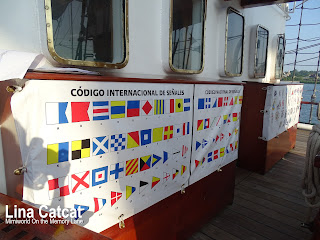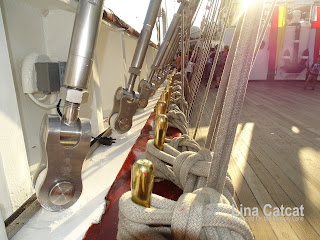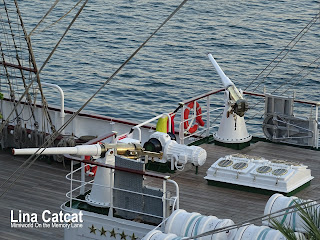ARM Cuauhtémoc docks at Vivocity Promenade
The Singapore Navy, ship enthusiasts and the public are excited to welcome ARM (Armada República Mexicana) Cuauhtémoc from Acapulco Guerrero, Mexico to Vivocity on the morning 19th July on their arrival. The navy cadets from far away hometown to sail the regions, to experience the countries' culture. Yes, I had visited Mexico in 1996 on holiday with my hubby and of course I had seen different ships. She (Cuauhtémoc) is the only survivor from a quartet of sister ships built by the Naval Shipyards of Bilbao, Spain, in 1982.For 35 years, cadets of the Mexican Navy have set sail, aboard her, around the world in their last year of training. She has made 34 instructional trips to 59 countries, clocking over 7,05,012 nautical miles, which is equivalent to going around the world 33 times, making much-requested and celebrated appearances at top-notch marine events like the Cutty Sark Tall Ships' Races, ASTA Tall Ships Challenges, Sail Osaka among others. She departed from India last month,26th Jun and it took 3 weeks to reach Singapore port at Vivocity Promenade on 19th Jul 2017 in the morning.
The relatively young 234-strong Cuauhtémoc crew, which has an average age of 24, will also be playing host to cadets and crew members from the Singapore Navy for cocktails and meals, and will later visit a naval base and navy vessel here.
The Armada Republic Mexicana (ARM) Cuauhtémoc - which began its journey from its home port, Acapulco Guerrero on 6th Feb 2017 – is on a nine month long goodwill voyage around the region. Captain Rafael Antonio Lagunes Arteaga, who assumed the position on October 16, 2016, is commandeering the ship, which has a crew strength of 234, 43 of whom are cadets of the Heroic Naval Military School of Mexico. There are four national and eight international guests from assorted institutions and friendly navies on the ship, which has a total of 217 men and 17 women on it on this trip.So we went to visit the Mexican Navy training tall ship today in the afternoon after late lunch at foodcourt. Upon reaching at the Vivocity Promenade, I looked in awe and was surprised to see such a huge majestic tall sailing ship that reminds me of pirate ship or a replica of the Indiana lookalike.
Security Point to the Gangway
There was not many people around and the queue is relatively short. We walked in and passed by the security point to proceed to the front where the aluminium gangway located.
Aluminium gangway to the ship
Upon reaching the aluminium gangway, we walked up to the ship where cadets greeted us.
Plaques on the deck of Mexican Sail Training ship
While on-board the ship, we noticed the inscription: "Por La Exaltacion Del Espiritu Marinero" which means "By the Exaltation of Seafaring Spirit".
Closeup of Plaque
Mexico's coat of arms - An eagle with a snake in its beak perched on a round plaque (it actually perched on a cactus that is seen on flag of Mexico hang on the tall ship), a inscription shown: ARMADA DE MEXICO BUQUE ESCUELA "CUAUHTEMOC" means NAVY OF MEXICO SHIP SCHOOL "CUAUHTEMOC". The coat of arms is derived from a legend that the wandering Aztec people were to settle at a location where they would see an eagle on a cactus eating a snake; the city they founded, Tenochtitlan, is now Mexico City.
Banner on Code of Signals
There is huge banner which indicated the codes - CODGIO INTERNACIONAL DE SENALES means INTERNATIONAL CODE OF SIGNALS. The International Code of Signals (ICS) is an international system of signals and codes for use by vessels to communicate important messages regarding safety of navigation and other related matters. The other signal in the banner indicated "CODGIO NACIONAL DE SENALES" means "NATIONAL CODE OF SIGNALS".
Cuauhtémoc Azlec ruler
Credit by Behindthename.com
ARM Cuauhtémoc named after the last Aztec emperor, is a Mexican Naval training sailing ship. The name of "Cuauhtémoc" means "one who has descended like an eagle" or "falling eagle" in Nahuatl. This was the name of the last Aztec emperor (ruler), ruling until he was captured and executed by the Spanish conquistador Hernán Cortés in year 1525.
Descending Eagle leading a tall ship
The figurehead of ARM Cuauhtémoc, a sail training vessel of the Mexican Navy, one of the participants in Tall Ships Races 2013.
Closeup: Metal figure of Cuauhtémoc
A glistening metal figure of Cuauhtémoc with his Aztec weapon looks straight ahead into the path of the Mexican Naval Academy's training vessel bearing his name. She carries the proud tradition of the Mexican seafarers to a port that once belonged to Mexico.
Halyard Ropes on a Mexican Sail Training Ship
There are ropes, ropes everywhere we saw everything from thick halyards (used to raise heavy yards) to thin, smooth, flexible sheets (used to control the orientation of a sail). We even saw rope tied around steel cable. The rigging looked incredibly complicated and intricately woven.
Teakwood Lifeboat
The deck itself is gorgeous, most of the pulleys we saw to help hoist that rope were made of teakwood, but also the stairways of the ship, the lifeboats, seating areas and doors were made of teakwood. There are even brass plates on the deck where heavy equipment is serviced, so that it doesn’t scratch the wood decking.
The ARM Cuauhtémoc sports a unique innovation: tercudos, or handwoven yellow “fluffy things” that cushion the rigging to protect the sails from damage. One of the cadets told me that when they are punished for misbehaviour, they are often ordered to make tercudos.
Lookout post on top
Where the assigned lookout stays near the top of the ship's mast, binoculars or telescopes are required items while working as the lookout. It usually advised that one brings a jacket or raincoat for the chillier winds or incoming storms.
Cadets master the skill of Climbing up the Masts
Cadet on the ship's mast
While on the sail training trip, cadets from the Heroic Naval Military School are instructed in the art of sailing, where they master practical exercises such as climbing up the ship’s masts and yards during their instruction cruise.
Cadets seen on top of masts and yards
Cadets balance on the masts and yards of Mexican Navy Sail Training Ship during their instruction cruise.
The cadets also learn the calls of the boatswain's whistle (the Call) - an old-fashioned instrument used for giving orders to the crew and honouring senior officers and distinguished visitors.
The cadets also learn the calls of the boatswain's whistle (the Call) - an old-fashioned instrument used for giving orders to the crew and honouring senior officers and distinguished visitors.
E.g. Boatswains Whistle/Call
The use of the Boatswains Call (the Call) in English ships can be traced back with certainty to the days of the Crusades, AD 1248. In its former days it was worn in English ships as an honoured badge of rank, as it had always been used of passing orders. A long ago in 1485 it was worn as the badge of the Lord High Admiral of England and was worn by his successor in office up to 1562.
Me & the sailor 'Roman' armed with a cutlass
The cadet 'sailor' his name is Roman who is the only one, armed with a long cutlass on his left posed a photoshot with me! It was interesting to note that the sentry at the gangway, a sailor is armed with a cutlass – a nice touch on a sailing ship! When I looked at him that reminds me of the cartoon character - Popeye the Sailor Man in his uniform. Giggles.
Crews posed for a photoshot!
As we walked and saw them selling souvenirs range of items - caps, pens, mugs, shirts, badges and so on. It seems that no one buys souvenirs from them and then we approached them for the photoshot then later the public joined in for the photoshot! What a sight! In the end, I bought a cap from them and paid in Sing-dollars . Well, souvenir items are not so expensive anyway. People thought the items paid in currency but they arrived in Singapore and therefore the gift items sold here are converted in Singapore dollar.
Ship's Kitchen
As we walked passed to the kitchen where the crews cook their meals while at sea or docks at their destination ports in 12 countries including Singapore. They also have their meeting room located nearby and of course inside the cabins are air-conditioning.
The slain warrior's name on a ship's bell
In the mid-deck of the ship, there is a bell located that rings. By looking at it, it looks like a nautical bell in the past. In olden days, every half hour, the watch on duty rings a bell to announce the time of day. The bell is rung in such a way that it represents the number of half-hour intervals that have elapsed since the watch came on duty. The bells that were rung onboard ship for a numerous reasons. For e.g. mealtime, time of the day, announcing a fire or danger of sorts and so on.
Huge Red Steering Ship Wheel
The Steering wheel of old could be seen on the ship dashboard from the back and mid-deck of the ship. Oh yeah, I remember I keep authentic brass and teakwood boat steering ship wheel at home that was given by someone whom I know, when I attended an "nostalgic" event 3 or 4 years ago.
There are SEVEN stars mounted on the walls of the Mexican Sail Training Ship which indicated "Menciones Honorificas" means "Honorable Mentions".
There are SEVEN stars mounted on the walls of the Mexican Sail Training Ship which indicated "Menciones Honorificas" means "Honorable Mentions".
Four Hawse Holes
Closeup of Hawse Hole
As we walked further up to the mid-ship, there are four Hawse holes (also known as cat hole) mounted on the starboard of the ship. Brass guides for the lines to run through when the ship is under sail.
We moved towards to the front of the ship, there are two cannons mounted on the shipboard on both side, very impressive saluting cannons on board – something that will be used later after her visits. To the front of the ship, there is a bowsprit is located.
Bowsprit of Mexican Navy
The bowsprit of a sailing vessel is a spar extending forward from the vessel's prow. It provides an anchor point for the forestay, allowing the foremast to be stepped farther forward on the hull. The bowsprit on a tall ship may be of considerable length and carry several forestays supporting the foremast. The headsails are stowed by tying onto the bowsprit when not in use. To minimise the risk of bowsprit and crew handling sail on it being buried in large waves while at high seas, it is normally angled upwards from the horizontal.
Bowsprit on Safety Netting
The bowsprit (also known as boltsprit) of Mexican Navy carries a trapeze of safety netting, preventing cadets from falling into the sea.
The ARM Cuauhtémoc will be open to the public from July 20 to 23, between 10 am and 6pm at the Vivocity Promenade, before it leaves for Manila (Philippines) on 24th July on the next leg of her voyage and then to Shanghai (China), Busan (South Korea), Kobe (Japan), Honolulu (LA) and finally back to Acapulco (Mexico) in the next few months.
The Mexican Navy Sailing Ship Cuauhtémoc at a glance.
Length: 220 ft 4 in (67.16 m) waterline
Launched: 9 January 1982
Beam: 39 ft 4 in (11.99 m)
Weight: 1,800 tons
Sail plan: Barque; Sparred length: 90.5 m; Sail area: 2,368 sq m
Cadets folding flag of Mexico
At 6pm plus, I saw two cadets and an officer folding the flag of Mexico in a respectful approach after one cadet lowered the flag pole with a rope, to keep secure till the next morning.
A quiet night
What is the ship look like when night falls...seeing all cadets relax listening music or talking to his family back home on their mobile phone.
Beautiful Tall Ship by night
It would be best if Singapore's 200th founding anniversary which will be in two years later in 2019, would invite a flotilla of tall ships, such as Mexico Navy’s Cuauhtemoc, for a grand celebration.































Nice coverage and photos. Thank you :-)
ReplyDelete